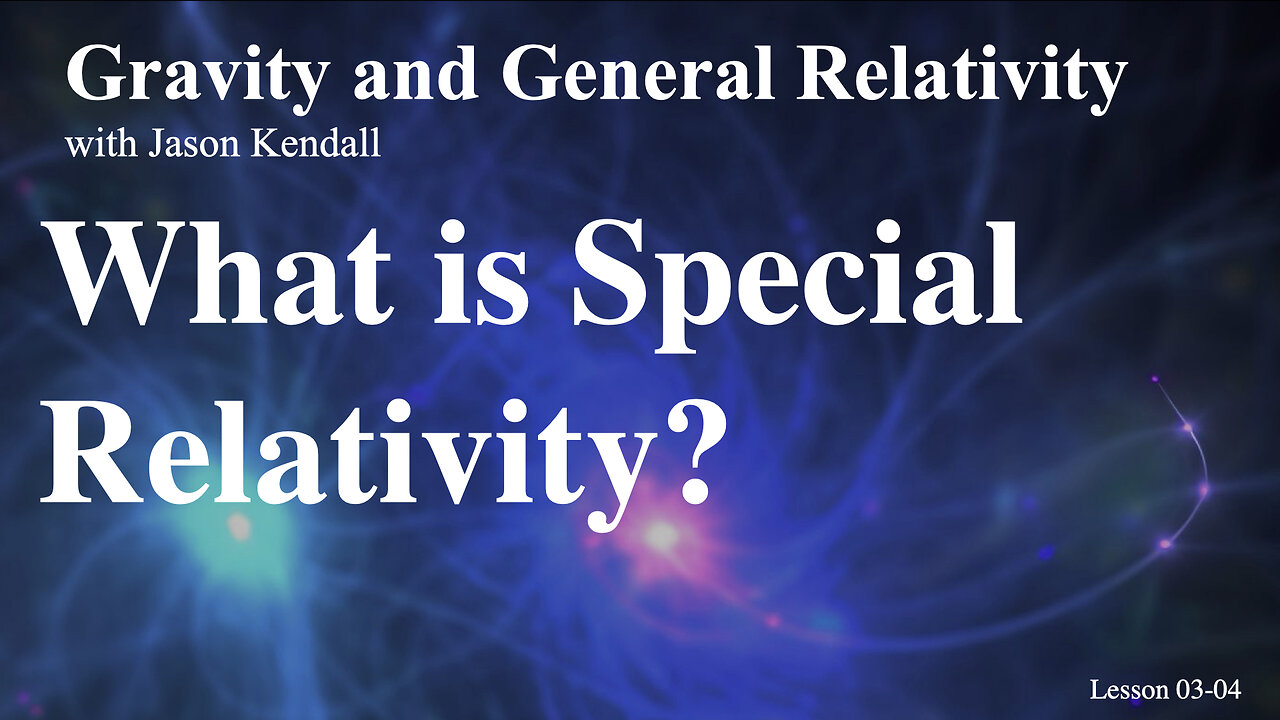Premium Only Content

The Nature of Light: From Galilean Relativity to Einstein’s Revolution
In this lecture, we continue our exploration of the fundamental nature of light and its relationship with the theories of relativity. Previously, we discussed the Michelson-Morley experiment, which sought to identify the medium through which light travels. This experiment revealed a significant conflict among the prevailing theories of the time—Galilean relativity, Newtonian mechanics, and Maxwell’s equations—prompting the need for a more coherent understanding of light and motion in the universe. Galilean relativity posits that all inertial frames are equivalent, meaning that an observer in a uniform motion cannot distinguish their state of rest from uniform motion. An inertial frame is defined as one that is either at rest or moving at a constant velocity, without any acceleration or rotation. This principle implies that speeds are additive; for example, if an individual on a moving ship shoots an arrow forward, the speed of the arrow is the sum of the ship’s speed and the arrow’s speed relative to the ship. In contrast, Newtonian mechanics introduces the concept of absolute space and absolute time. According to Newton, time progresses uniformly across the universe, independent of any observer’s position or motion. This perspective assumes the existence of a universal clock that governs the passage of time, allowing for a consistent understanding of events occurring in space. In Newton’s framework, time and space are separate entities, and actions in one do not influence the other. While Newtonian mechanics provides a solid foundation for classical physics, it presents challenges when reconciling with Maxwell’s equations of electromagnetism. These equations, derived from extensive experimentation, describe the behavior of electric and magnetic fields and suggest that light is a propagation of electromagnetic waves. Maxwell’s equations imply that light travels at a constant speed, independent of the motion of the observer or the source of light. This raises a critical question: if the speed of light is constant, how does it interact with the relative motion described in Galilean relativity? According to Newtonian mechanics, if you were to shine a flashlight from the bow of a moving ship, the speed of the light should be the sum of the ship’s speed and the speed of light as measured from an external observer. However, Maxwell’s equations assert that the speed of light is invariant, creating a contradiction between these two frameworks. The Michelson-Morley experiment aimed to resolve this conflict by detecting the presence of the luminiferous ether, a hypothetical medium through which light was thought to propagate. By measuring the speed of light in different directions as the Earth moved through the ether, they anticipated observing variations in the speed of light due to an ether wind. However, their experiment yielded null results, demonstrating that the speed of light remained constant regardless of the direction of measurement or the Earth’s movement. This finding contradicted the existence of the luminiferous ether and cast doubt on the Newtonian framework. To understand the implications of these discoveries, we must also consider earlier efforts to measure the speed of light. Galileo Galilei attempted to measure light’s speed in 1638 by using lanterns placed at a distance. His methods were inconclusive, leading him to conclude that light traveled exceedingly fast, perhaps instantaneously. Ole Rømer further refined the measurement in 1676 by observing the transits of Jupiter’s moons, determining that light’s speed was approximately 220,000 kilometers per second based on the discrepancies in observed transit times. In 1728, James Bradley’s work on stellar aberration provided another estimation of light’s speed, refining it to about 300,000 kilometers per second. Subsequent experiments, including those by Hippolyte Fizeau in 1850 and Louis Essen in the early 20th century, further validated the speed of light at approximately 299,792 kilometers per second. The results of the Michelson-Morley experiment, combined with these earlier measurements, led to a profound realization: the speed of light is not merely a relative quantity; it is constant across all frames of reference. This radical departure from Newtonian mechanics set the stage for Albert Einstein’s theory of special relativity in 1905, which eliminated the need for an ether and established the principle that the laws of physics are the same for all observers, regardless of their relative motion. Einstein’s special relativity introduced several groundbreaking concepts, including time dilation and length contraction, which further elucidated the nature of space and time. Time is perceived differently for observers in relative motion; for example, a clock moving at high speeds will appear to tick more slowly compared to a stationary clock. Similarly, objects in motion will appear shorter in the direction of their travel from an outside observer’s perspective. In conclusion, the exploration of light and its relationship with motion has undergone significant transformations throughout history. From the early ideas of Galilean relativity and Newtonian mechanics to the revolutionary insights of Maxwell and Einstein, our understanding of light has evolved dramatically. The resolution of the conflicts between these theories ultimately led to the development of special relativity, providing a coherent framework for understanding the interactions between light, space, and time. As we continue to investigate the nature of light, we recognize its importance as a fundamental aspect of our understanding of the universe.
-
 LIVE
LIVE
The Sufari Hub
2 hours ago🔴WE ARE FEATURED - BLACK OPS 7 EXTRACTION MODE - LEVEL GRINDING
104 watching -
 44:51
44:51
American Thought Leaders
16 hours agoHow This Tech Can Break China’s Rare Earth Monopoly | Dr. James Tour
10.9K9 -
 9:46
9:46
MattMorseTV
18 hours ago $27.16 earnedTrump just SHUT DOWN a $287,000,000 FRAUD RING.
44.5K105 -
 LIVE
LIVE
JakRazGaming
1 hour agoPlaying Hogwarts Legacy!! Playthrough Stream 4
165 watching -
 1:16
1:16
From Zero → Viral with AI
22 hours ago $1.16 earnedAI Isn’t Killing Work. It’s Killing the Wrong Kind of Work.
5.96K15 -
 2:47:27
2:47:27
Squaring The Circle, A Randall Carlson Podcast
21 hours agoEPIC! Randall & Sabin Howard, Master Sculptor Known As "Michelangelo of America," talk WAR or PEACE!
8.14K2 -
 22:42
22:42
Benjamin Sahlstrom
1 day ago $19.21 earnedHow To Refill 1lb Portable Propane Tanks!
116K15 -
 46:39
46:39
The Bold Lib
1 day agoOwen Shroyer: BOLDTALK W/Angela Belcamino
15.6K24 -
 7:57
7:57
Blackstone Griddles
1 day agoDouble Barrel Sausage Sandwich | Blackstone Griddles
31.9K3 -
 32:24
32:24
Forrest Galante
14 hours agoHunting and Eating The World's WORST Fish (Everglades At Night)
116K8